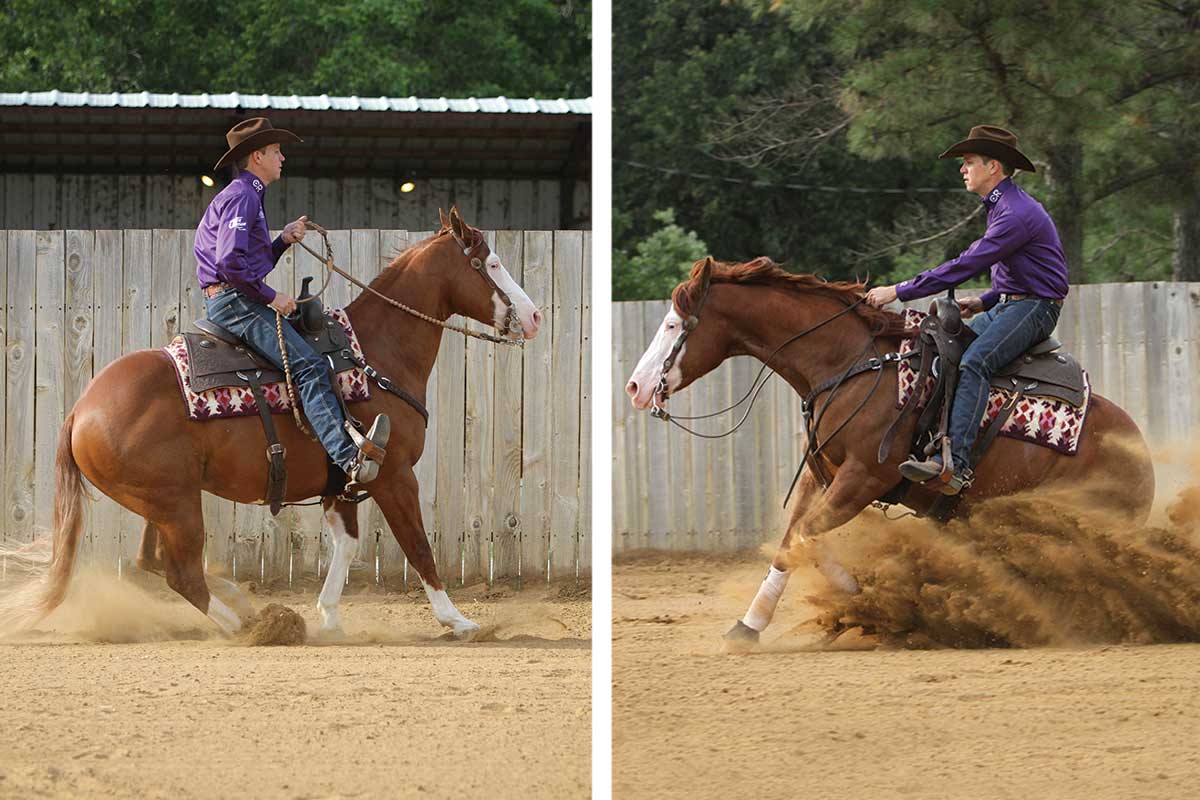
There’s no getting around it: Ranch riding is the fastest-growing class across almost all breeds. Thanks to a solid training foundation, you could add the event to your reiner or cow horse’s repertoire with minimal training effort on your part. That means one more class for you to compete in and greater diversity for your horse’s skill set.
[READ: Have a Snappy Ranch Riding Spin]
Here I’ll discuss three must-have traits for your horse’s way of going before you consider ranch riding, and then break down how each required ranch riding maneuver correlates to a similar maneuver in reining patterns. I’ll also discuss how ranch riding patterns can help improve your reining and reined work (for working cow horse) patterns.
THE MUST-HAVE TRAITS
Reiners and cow horses are some of the best-trained performance horses today. Their fundamentals and foundation make transitioning to ranch riding almost effortless. Plus, their lineage leads to the body type that lends itself to succeeding in ranch riding.
But there are three traits they must have; otherwise it’s a deal-breaker.
Is he a good mover and pleasing to watch? Movement goes a long way in ranch riding. Cadenced, rhythmic gaits and true extensions play a large role in a ranch riding score. A horse with eye appeal—color, chrome, and wow factor—that’s pleasing to look at, has expression in his ears, and shows willingness to complete the pattern stands out to the judge.
Does he steer and guide well? Reiners can be what we call “patterned,” meaning they know the pattern they’re running and go by that instead of being truly guided. Most reining cues happen in the middle of the arena—especially spins and changes of speed and leads. These transitions and changes in direction happen anywhere in the arena in ranch riding. This means your horse must be truly guided by your cues, and do it in a willing, athletic manner.
Does he carry his body naturally? If yours is a reiner that travels behind the bridle or packs his head excessively low, ranch riding might not be a good fit for your horse. Horses that travel with a lot of frame or collection may take more time to settle into ranch riding’s style.
With those three characteristics, you can move on to finessing your horse’s reining maneuvers for ranch riding.
[WATCH: Ride Through a Ranch Riding Pattern with Bud Lyon]
THE MANEUVERS
Four ranch riding maneuvers align well with reining: turns, stops, lead changes, and the back-up. Walking and trotting gaits, logs, and a sidepass are found in ranch riding and are new skills for a reining horse, but with a solid foundation they shouldn’t be a problem. All of these maneuvers should emulate how they’d be used when working on a ranch—effectively, correctly, and willingly.
Here I’ll break down each maneuver and discuss the slight differences between executing them in reining versus ranch riding. I’ll also offer a key tip for ranch riding success.
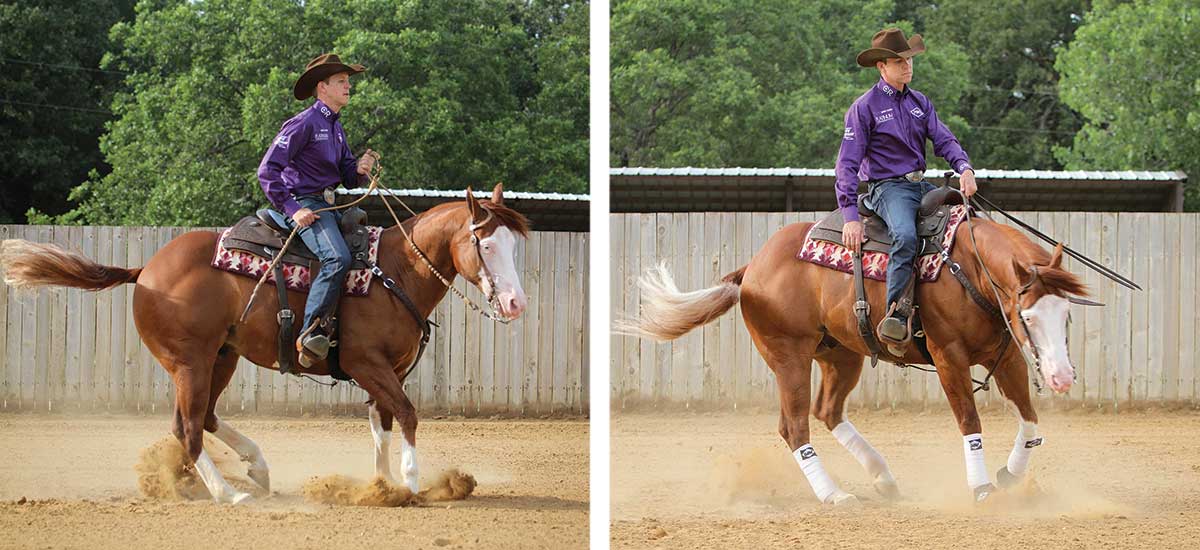
Maneuver: Spins/turnarounds.
How it looks in reining: Patterns consist of four to four-and-a-quarter spins. They start slow, and build speed, screeching to a halt at the designated count. The crescendo of speed and cadence is controlled and measured, but picks up before the first revolution is halfway complete. The horse locks in at the desired speed, and then shuts down precisely to end the maneuver where the pattern designates. The horse can then pause before starting his next maneuver, whether a set of spins in the other direction or a lope departure.
How it looks in ranch riding: Spins are short and sweet in ranch riding patterns, usually covering no more than one-and-a-half revolutions. (An advantage for cow horses trying this event.) This best emulates how turns are executed on a ranch when working cattle. Four spins in a row simply aren’t practical on the ranch.
There’s no time for a slow start here. Your horse must be responsive and accurate. Once he’s halfway through a turn, when the reiner is winding up, it’s almost time for the ranch rider to stop. Judges in ranch riding don’t critique the cadence of the spin as harshly as in the reining, but they do expect accuracy. And there’s no time for a pause. Your ranch rider should have a more fluid presentation, going from one maneuver to the next.
[READ: Teaching Your Horse to Turn]
Key tip for ranch riding: When you’re schooling at home and warming up for a class at a horse show, be sure that your horse is paying attention and responsive to your cues. Don’t fire him up unnecessarily, but expect a response when you ask him to turn. Also, be sure to practice ending your spins. You’ll incur a penalty for overturning in ranch riding, just as in reining.
Help for Your Reining Scores
Competing in ranch riding can help your horse in the reining pen, too. Here’s how.
• A different kind of ‘alone time.’ Getting your reiner in the show pen to do something other than a reining pattern—without any other horses—is a tough thing to come by. It’s valuable because it can help ease any pen anxiety he’s developed from being shown.
• Help bust anticipation. If your horse thinks he’s smarter than you are and jumps the gun when you show, completing an unfamiliar pattern means he must wait and listen for your cues instead of anticipating them.
• A needed ‘brain break.’ We all know horses can face burnout in the show pen, leading to a sour attitude. Giving your mount something else to focus on can be a necessary break that will bring him back fresher his future reining events.
Maneuver: Stops.
How it looks in reining: The sliding stop is the hallmark of a reining horse. The rundown builds speed until the horse hits the dirt with his hind end and slides. Reiners are bred for this maneuver—yes, part of it is training; but a large portion of stopping ability comes from genetics.
How it looks in ranch riding: Stops are fundamentally the same for ranch riding. Your horse should stop square and balanced, but the front legs don’t need to “pedal” (see photo on page 73) in the ranch riding the way they do in the reining. It’s the maneuver you’ll have to put the least effort in when adding ranch riding to your reiner’s roster of classes.
However, judges don’t want ranch riding to become a sliding contest. Most stops are called for from a walk or trot; not a gallop. The patterns don’t allow the reining-style building of speed that leads to a butt-dragging stop because that’s not necessary on a ranch. I’ve heard some ranch riding competitors complain about reiners wearing slide plates in ranch riding and that not being typical of a ranch horse. I think that’s short-sighted. Versatility, as when a reiner or cow horse competes in a class outside his norm, should be accepted and even rewarded, if done correctly.
Key tip for ranch riding: Key in on responsiveness. Stop your horse from all gaits and extensions so he’s listening and ready to stop when you cue rather than just at the end of a rundown. If your horse is responsive, he’ll stop squarely at your cue where the pattern designates, from any gait.
Maneuver: Lead changes.
How it looks in reining: A lead change is functionally the same no matter the class, from reining to horsemanship to Western riding. All lead changes have three key elements: forward motion, elevation of the horse’s back and shoulders, and lateral movement. What you see in a flying lead change in reining shouldn’t be functionally different in ranch riding.
However, many reiners are only trained to change leads in the middle of the figure eight that’s the base of their pattern. That’s where the key tip, below, is essential.
How it looks in ranch riding: Both flying and simple lead changes are acceptable in ranch riding, but all things being equal, a well-executed flying lead change demonstrates a higher degree of difficulty.
Key tip for ranch riding: Practice changing leads all over the arena when schooling at home. Be sure that your horse doesn’t use the middle of the pen as a crutch to change leads when you move your hand, shift your weight, and change directions. Ensure that he has a solid lead change anywhere in the arena, and even when you ride outside the arena.

Maneuver: Back-up.
How it looks in reining: Style plays a large role in reining, and the current style tends toward quick feet and poll flexion in the back-up.
How it looks in ranch riding: A ranch horse’s back-up is just as willing as the reiner’s, but it’s not as fast and his nose might not be tucked quite as far in.
Key tip for ranch riding: For this event, the back-up should be willing, just as in reining. Judges don’t want to see you drag your horse backward. If my horse labors to back, I use my feet, alternately on each side, to help get him unstuck, pick up his shoulders, and respond to the pressure.
[READ: Improve Your Horse’s Lazy Backup]
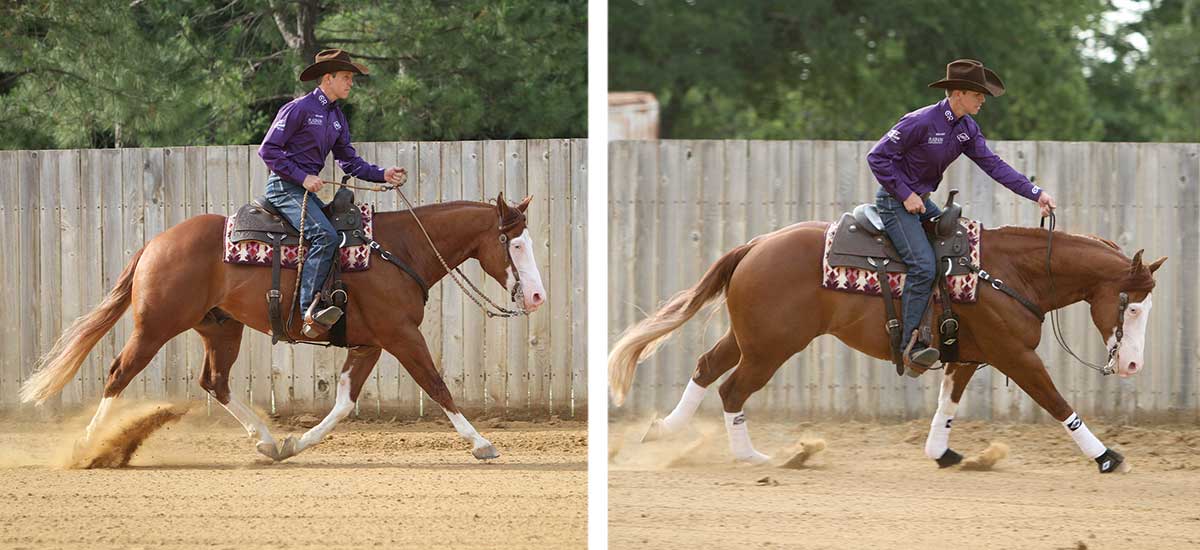
Maneuver: Transitions and gait extensions.
How it looks in reining: The transition from small, slow circles to large, fast circles is a major component in reining, so your horse shouldn’t have problems with that change of gait. But there’s no trotting in reining, other than when warming up or maybe entering the pen for a pattern that starts in the middle of the arena. Trotting—into lope departures, out of rollbacks, through lead changes—is a penalty in reining and is actively discouraged. This creates habitual patterns so you can avoid penalties when competing. Even worse, your horse might lack confidence transitioning from a walk to a trot or a lope to a trot.
Aside from steering, one of the must-have traits discussed earlier, gait transitions can be the most difficult maneuver for a reining horse to master. But it can be done.
How it looks in ranch riding: Upward and downward transitions are a key component to ranch riding patterns, and they’re executed precisely. The intention is to mirror what you’d see a horse doing on a ranch—walking as he leaves a gate, jogging to approach a cow, loping across a pasture. A ranch horse, unlike a reiner, uses all of his gaits.
Key tip for ranch riding: I cluck and say “whoa” during reining patterns, but I use more verbal cues with my ranch riding horses—especially in downward transitions or when a horse starts to get ahead of me. For example, to go from an extended trot to a walk, I calmly tell my horse to walk, along with using my body cues. Or when we’re working at an extended walk and he feels like he might break into a trot, I repeat a “walk” verbal cue. This helps my horse’s confidence in terms of knowing what I want him to do.
At home, be sure to practice all gait extensions to build your horse’s familiarity with all levels of each gait. And be sure that you’re extending gaits (lengthening stride), not simply traveling with faster footfalls.
[READ: Speed Transitions with Clint Haverty]
A Change of Bits
When I’m working with a horse to settle into ranch riding, it sometimes helps to change his bit so he can settle into the desired ranch riding frame. A light correctional bit or an Argentine snaffle can help. If the horse is younger than 6, he can be shown in a snaffle or hackamore in most breed association events. This differs from most NRHA events, which don’t allow snaffles or hackamores.
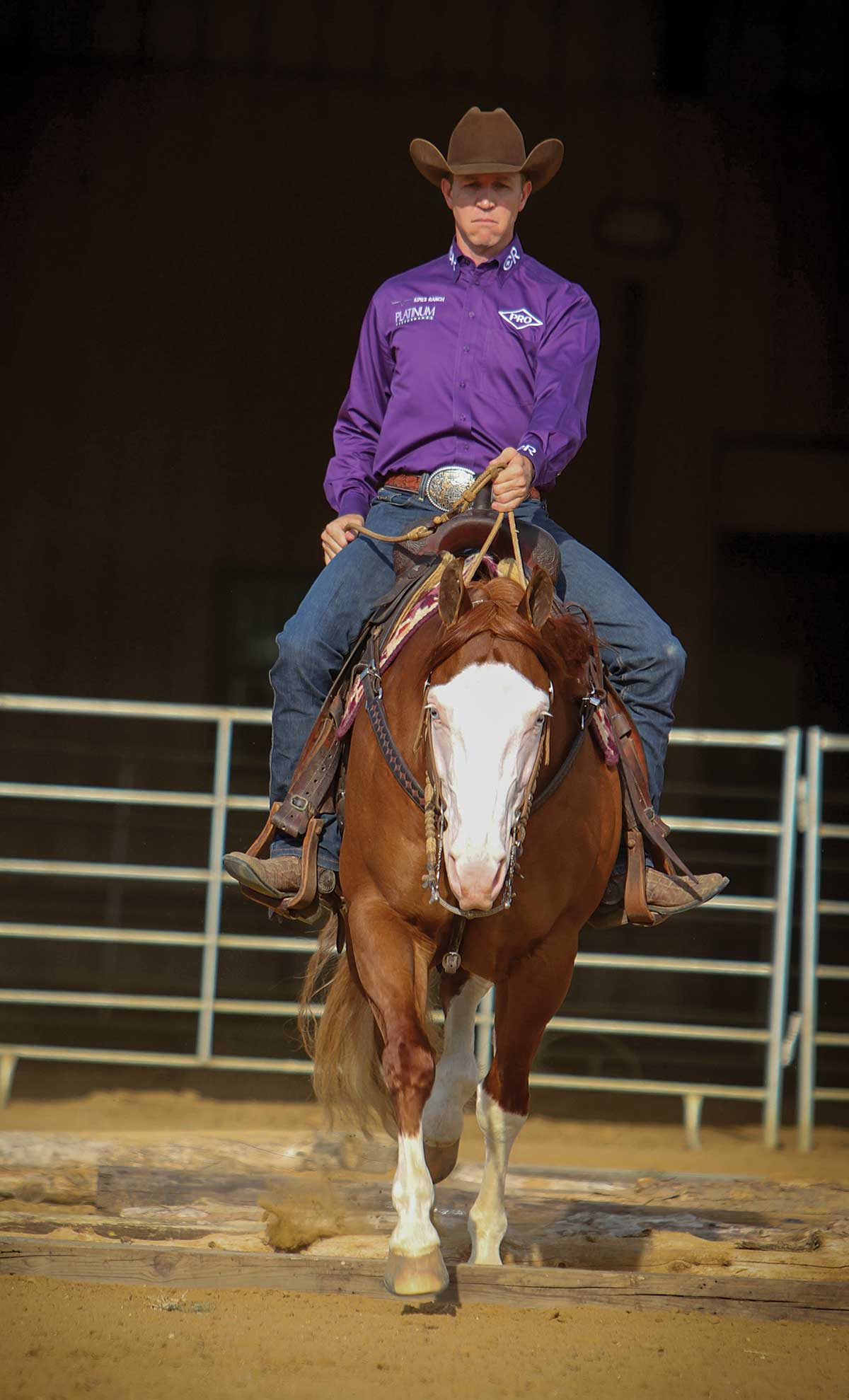
Maneuver: Logs.
How it looks in reining: Obviously, there are no logs in reining patterns. I’ve had the occasional reining horse that’s scared of the logs, but more often they’re lazy and plod through the obstacle, hitting each log.
How it looks in ranch riding: The pattern can call for any gait over the logs, with more space between each timber for faster gaits. A straight, cadenced approach makes foot placement between the logs less a worry. Then you can focus on riding all the way through the obstacle—until the last foot steps over the final log—for a clean execution.
Key tip for ranch riding: Begin with one log on the ground. Cross it at all gaits until your horse doesn’t think twice about it. Once you cross a series of logs, keep a steady cadence from approach to finish. Slowing down means he’s likely to hit a log. Building speed means your horse is “going without you” and is worried about the obstacle, which also leads to hitting logs. Teach your horse to be confident, relaxed, and cadenced over the obstacle.
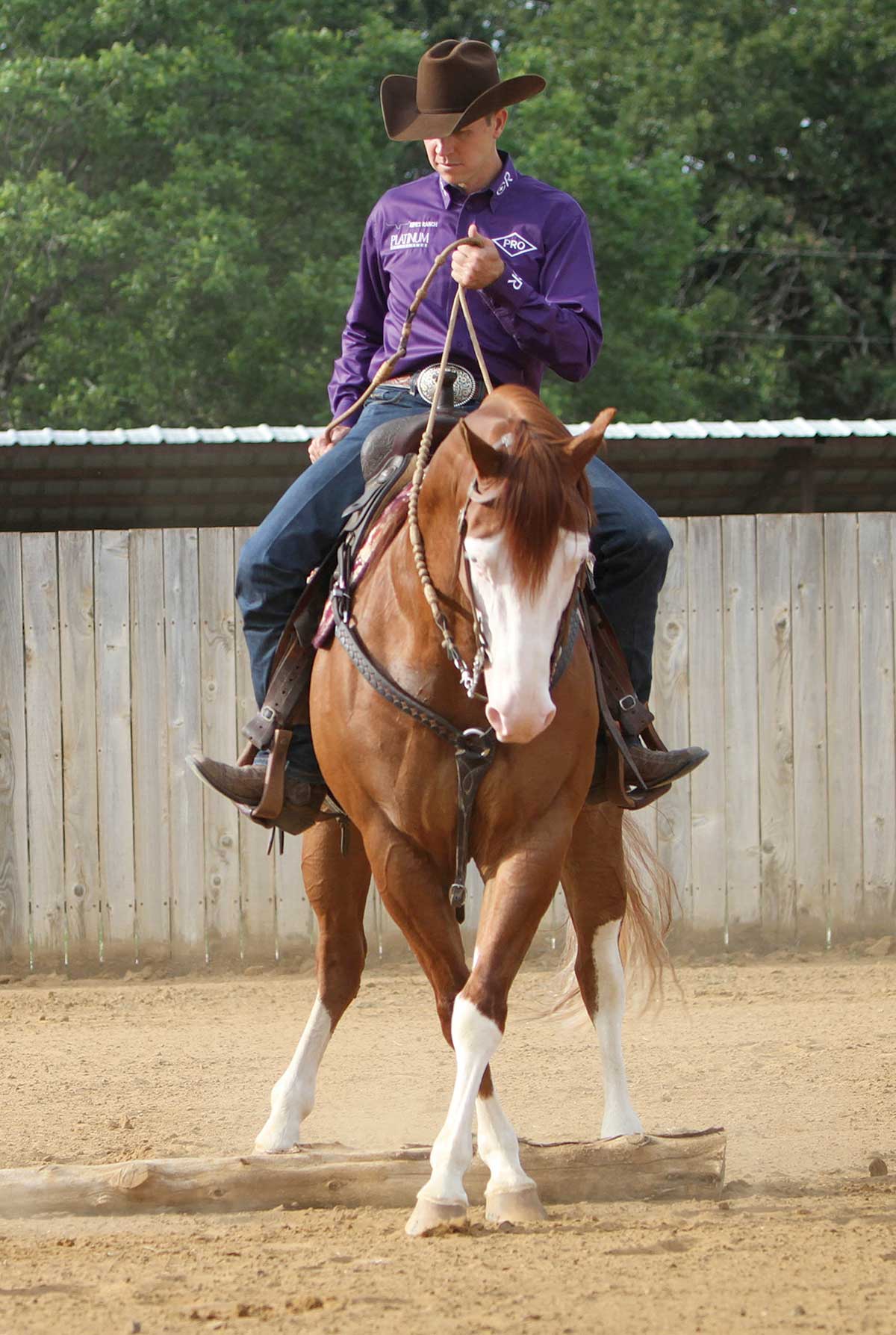
Maneuver: Sidepass.
How it looks in reining: You won’t see a sidepass in a reining pattern, but a reining horse should have lateral movement in his bag of tricks. It’s essential for a correct lead change, as well as to keep your horse square in his shoulders.
How it looks in ranch riding: Every ranch riding pattern requires a sidepass obstacle, usually over a log placed on the ground. The judge can call for a sidepass in both directions or just one, usually with four or five consecutive steps to complete the maneuver.
Key tip for ranch riding: Your reiner might be accustomed to moving parts of his body laterally, but not his entire body. Take the time at home to work on whole-body lateral work, rather than isolating one part of his body.
[READ: Moving Your Horse Off Your Leg]
Bud Lyon, Tioga, Texas, has experienced great success at all levels in his horse-showing career, from youth to open. Along with training open horses, he takes pride in coaching amateur and youth riders to achieve their goals. His coaching and communication abilities make him a sought-after clinician for his areas of focus—reining and ranch riding. Learn more at budlyonperformancehorses.com.






